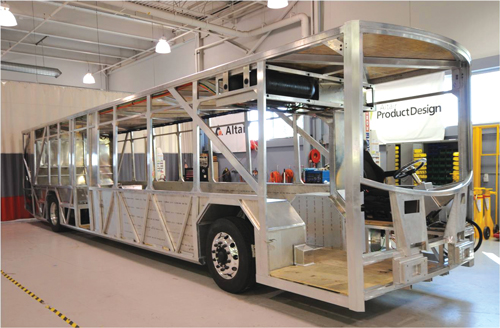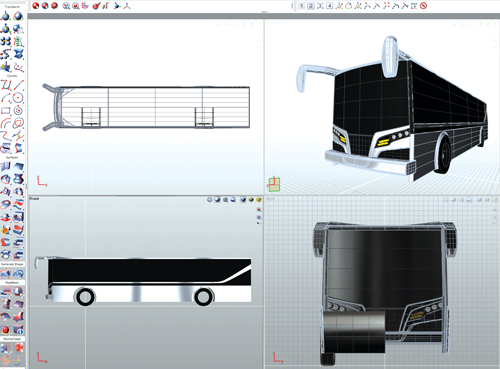December 1, 2011
By Kenneth Wong
Digital prototyping, a term adopted by design software maker Autodesk as its motto, is also becoming the mantra of leading simulation software developers. It’s understandable: The proposition to substitute foam and clay models with digital models favors software makers’ bottom line.
Automotive and aerospace manufacturers seem to have found value in this approach. In many operations once accomplished with physical mockups and scale models, top-tier car and plane makers now use a variety of digital replicas (CAD models for design evaluation, mesh models for simulation, polygon models for visualization, and so on). So, why are engineers from simulation software maker Altair Engineering personally getting involved in the construction of a full-scale, 40-ft. model of a transit bus?

The LCO-140H has a lightweight aluminum construction. Structural support
was placed according to analysis results.
The LCO-140H, which stands for “low cost of ownership, first 40-ft. hybrid vehicle,” is a life-sized, operational model. It’s the centerpiece of Altair’s BUSolutions project—and a testament to Altair engineers’ belief that theoretical findings should be backed up with real-world tests. The project is hybrid in more than one way. It’s a private-public partnership, realized in a physical-digital workflow.
How It Began
In 2004, Altair and Automation Alley, Michigan’s largest technology business association, received a $550,000 federal grant to design and build two prototype buses powered by state-of-the-art technologies. The plan is to make the models available for sale to transit authorities across the U.S. when they become a reality.
“The program started as an Altair initiative, where we wanted to demonstrate our engineering technologies on a transit bus,” recalled Jeff Hopkins, BUSolutions design manager for Altair ProductDesign. “We chose the transit bus because that industry was really not up to par with the standards in the automotive industry. Our objective was to produce a transit bus with a low cost of ownership—plain and simple.”
Eventually, BUSolutions received public funding from FTA and the Michigan Economic Development Corporation, and the Detroit Department of Transportation, along with sponsorship and assistance from Suburban Mobility Authority for Regional Transportation (SMART), Parker Hannifin, Meritor (a drivetrain system supplier), PRAN (a control systems provider), and other private entities.
When the first prototype bus was ready for action, Altair drove it to the Proving Ground in Romeo, MI—a 3,880-acre, 100-mile driving ground maintained and operated by Ford for real-world vehicle tests.
According to the U.S. Federal Transit Administration’s report titled “Transit Bus Life-Cycle Cost and Year 2007 Emissions Estimation,” the cost of a diesel-electric hybrid is $531,605, and its lifecycle cost is $987,176. Altair’s model would cost $410,000, with a lifecycle cost of $725,020.
Altair points out, “The LCO-140H Series Hybrid Hydraulic bus more than doubles the fuel economy of today’s diesel powered buses and offers transit authorities the opportunity to reduce fleet costs by 20% while dramatically lowering emissions. With a purchase price over $100,000 lower and 30% better fuel economy and lower emissions, the lifetime cost to own a LCO-140H Series Hybrid Hydraulic bus is estimated to be 30% less than hybrid electrics.”
The Best of Both Worlds
Two notable features of Altair’s bus design are the bus’ hydraulic hybrid powertrain and its lightweight aluminum structure. The powertrain deployed by Altair’s bus is distinctly different from the electric hybrid variety used by some, notes Hopkins. He explains, “For instance, when restoring regenerative energy from the breaking system, about the best you can get from an electric hybrid system is 25% of the energy recovered off the road. With a hydraulic hybrid, you’re talking in excess of 70%.”
In designing its powertrain, Altair used Parker Hannafin’s pure series hydraulic hybrid powertrain. According to Altair, Parker’s system is “unique in that the engine is not connected to the rear wheels of the vehicle. This decoupling of the engine from the drive wheels offers several advantages, including: the ability to recover and store as much as 70% of the energy from braking, reduced brake wear, which extends brake life; an engine management system that optimizes the vehicle’s engine for reduced fuel consumption; the ability to drive the vehicle with the engine off, significantly reducing carbon emissions in depots and contributing to reduced fuel consumption.”
Because of the number of frequent stops along a transit bus’ route, the chosen powertrain system is expected to offer significant cumulative benefits over the vehicle’s lifetime.

solidThinking was used to quickly evaluate multiple design themes for the
transit bus.
As a cost saving measure, Altair engineers relied primarily on the digital mockup for their experiments, such as different placements of internal components and configurations of length and height of the chassis to make the bus structurally sound.
The bus, according to Hopkins, was designed with a clean sheet approach. “This enabled Altair to do things right from the start,” he said. “When you start with an existing design you need to make compromises to make things work. Because Altair had full control from the digital model through the physical build, we were able to do things right the first time.”
The initial digital model of the bus was built in SolidWorks, a 3D mechanical design software. Later, it was refined using solidThinking, a conceptual design and styling software from Altair. Tim Smith, director of design engineering, Altair ProductDesign, explains, “From an industrial design standpoint, the ease of use of solidThinking in capturing aesthetic design intent, enabling easy modification, and reuse of existing geometries through the feature ConstructionTree made organization seamless in the design process. This work process allowed multiple design themes to be generated very quickly and allowed quick evaluation within the context of the overall bus structure through the data interoperability between solidThinking and SolidWorks’ CAD package.”
In designing the bus, Altair’s use of digital simulation helped engineers identify potential problems in advance, especially in the diagonal members visible from the front and rear windows of the bus. “The bus wants to grow organically. If you look at our design, you’ll see that we’ve made room for that,” said Hopkins. “Typical buses confine the structure to orthogonal members. When Altair’s topology software was applied, we let the material grow where it wants to be, and many times that isn’t a perpendicular intersection. In this case, the analysis identified a load path through the front and rear windows, and that is where we gave it structure.”
Hybrid Transit on Display
In September, Altair’s LCO-140H was publicly unveiled at a technology demonstration. (For a report from the event, read “Altair Engineers Think Big to Build a Better Bus” at deskeng.com/articles/aabcag.htm.) The bus was also on display at the American Public Transportation Association Expo (Oct. 2-5, 2011) in New Orleans, LA.
Mike Heskitt, chief operating officer at Altair ProductDesign, said, “BUSolutions demonstrates Altair’s expertise and capabilities as a concept-to-release, full vehicle development partner.” Going forward, as the bus gets closer to commercialization, Altair will seek to implement additional features, such as a swing-away and folding seat for handicap seating.
Kenneth Wong, is senior editor of Desktop Engineering magazine. He can be reached via [email protected].
MORE INFO
Subscribe to our FREE magazine, FREE email newsletters or both!
About the Author
Kenneth Wong is Digital Engineering’s resident blogger and senior editor. Email him at [email protected] or share your thoughts on this article at digitaleng.news/facebook.
Follow DE





